When your baby reaches four months, each day brings exciting changes and new ways to connect.
At this stage, you might notice more smiles, coos, and curiosity, making it the perfect time to introduce 4-month-old baby activities that encourage growth and bonding. From simple games to gentle routines, these little moments make a big difference.
In this blog, I’ll walk you through what to expect at four months, fun motor skill games, sensory play, cognitive and social activities, language-building ideas, daily routines, Montessori-inspired play, safety tips, and helpful resources.
My goal is to give you clear, practical ways to make playtime meaningful while helping your little one thrive.
What to Expect from a 4-Month-Old Baby
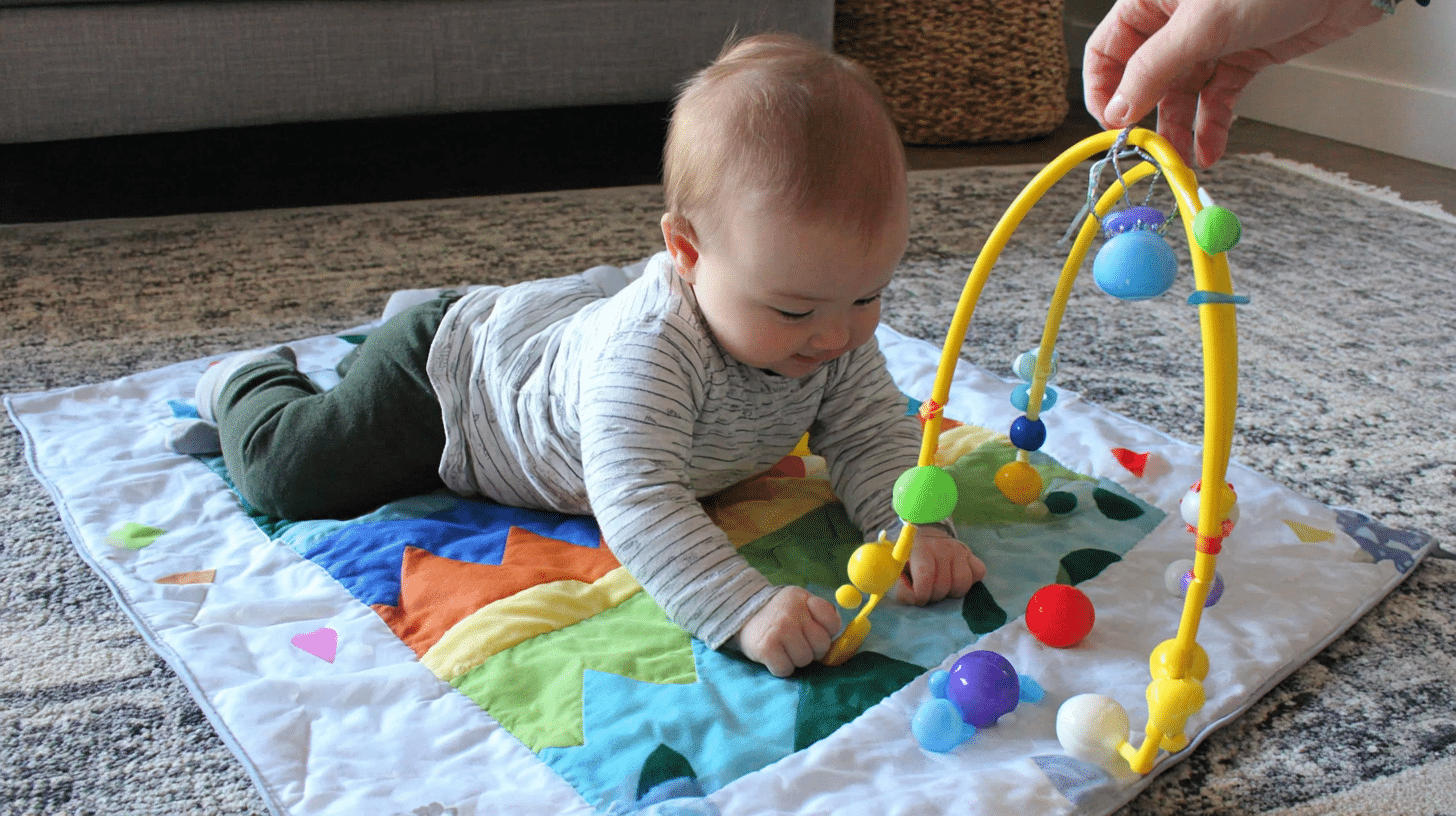
At four months, babies usually become more active and interactive. Many begin to roll from tummy to back, reach for toys, and grab objects with their hands.
You’ll likely hear more cooing and babbling as they experiment with sounds, and they may start recognizing familiar faces and voices from across the room.
Every baby develops at their own pace, but if your little one isn’t making eye contact, showing interest in sounds, or attempting basic movements like rolling, it’s a good idea to talk with your pediatrician for guidance and reassurance.
Fun Activities for a 4-month-old
At four months, your baby is building strength and coordination, and simple movement-based play can support this growth.
1. Tummy Time Variations
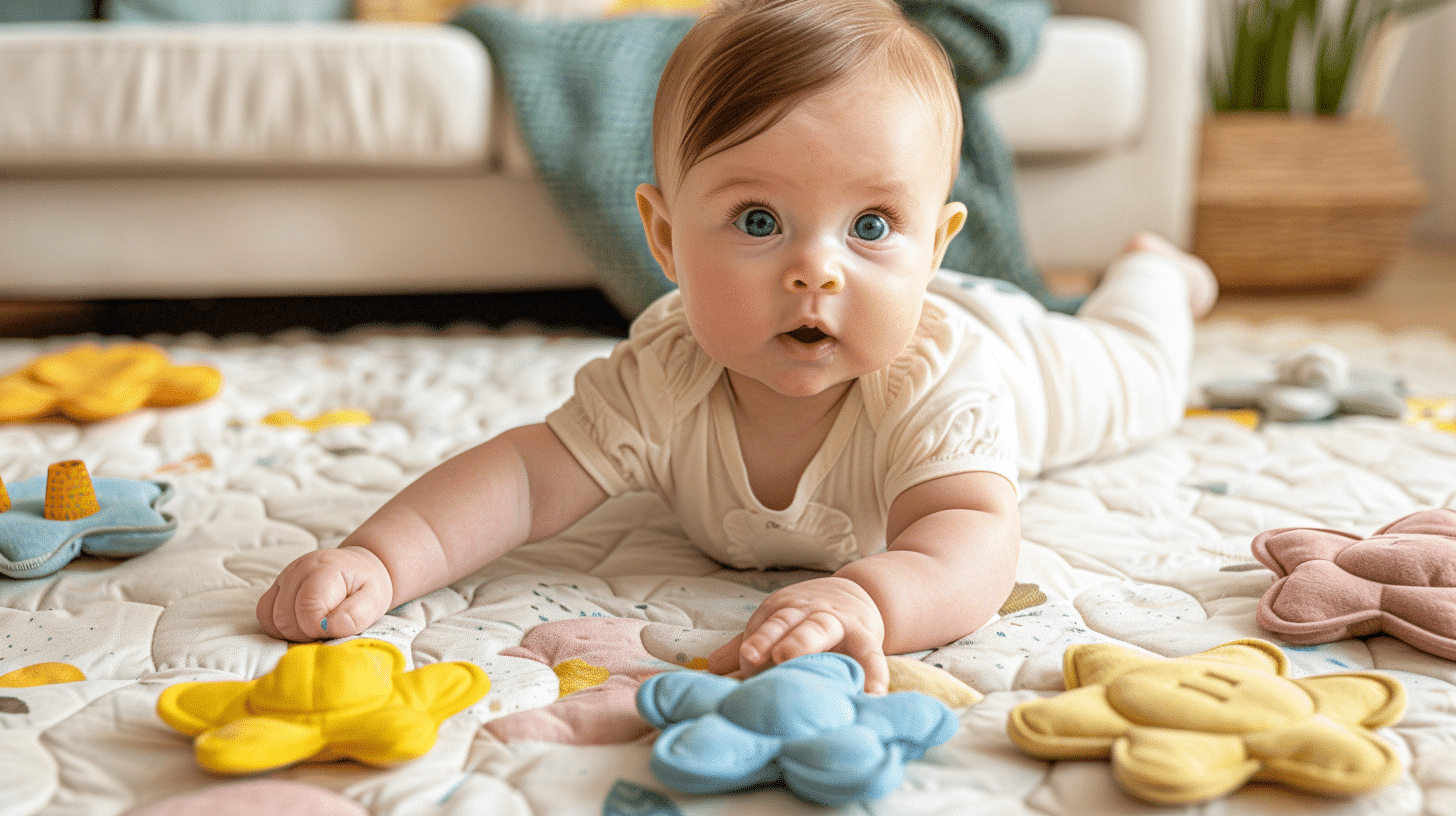
Place your baby on a soft mat with toys just out of reach to encourage lifting, reaching, and turning.
You can also place your baby on your chest, which makes the activity more comforting while still strengthening their neck and shoulder muscles.
Varying the position keeps tummy time interesting and prevents fussiness. Aim for several short sessions throughout the day instead of one long stretch, as this helps build strength gradually without overwhelming your baby.
2. Rolling Games

A safe floor mat provides the perfect space to encourage rolling practice. Gently guide your baby to roll from back to tummy by placing a favorite toy just to the side, prompting them to reach and move toward it.
Rolling not only strengthens the core and back but also helps babies gain awareness of how their body moves in space.
Repeating this activity daily supports coordination and makes transitioning between positions easier over time.
3. Supported Sitting and Standing

Use firm pillows to prop your baby in a sitting position, giving them the chance to look around from a new perspective.
This position helps babies interact more with their environment and practice balance. You can also support your baby under the arms while letting them “stand” with your assistance.
These short sessions strengthen leg muscles and prepare them for future milestones such as crawling and walking. Always supervise closely and keep sessions brief to avoid strain.
4. Texture Play
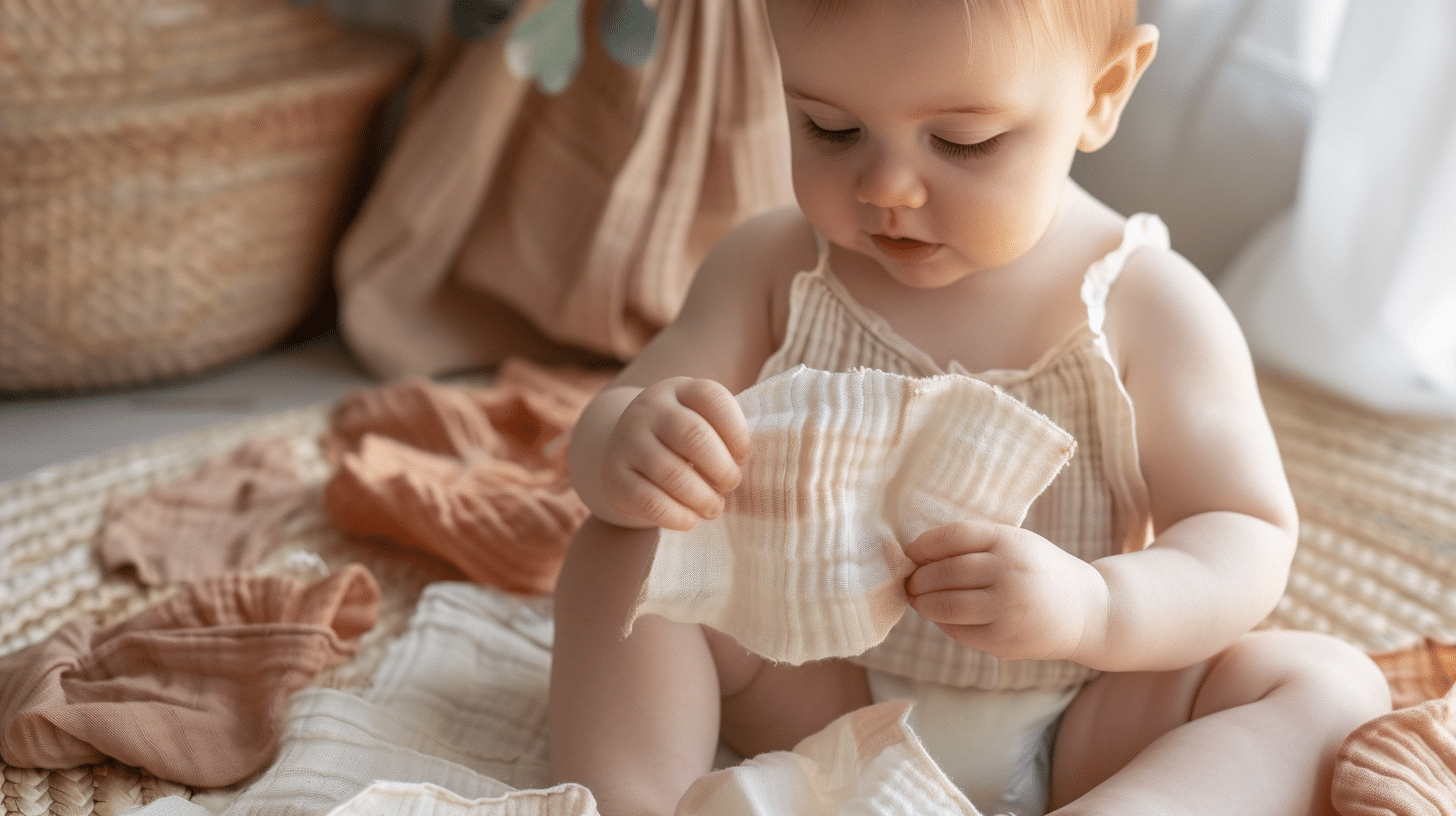
Offer your baby safe items with different textures, such as soft cloths, crinkle paper, or baby-safe sensory bags.
Touching different textures builds touch awareness and strengthens fine motor skills as babies learn to grasp and release.
Rotate the items regularly to keep the experience fresh and engaging. Always supervise closely, as babies at this age may try to put everything in their mouths.
5. Mirror Time
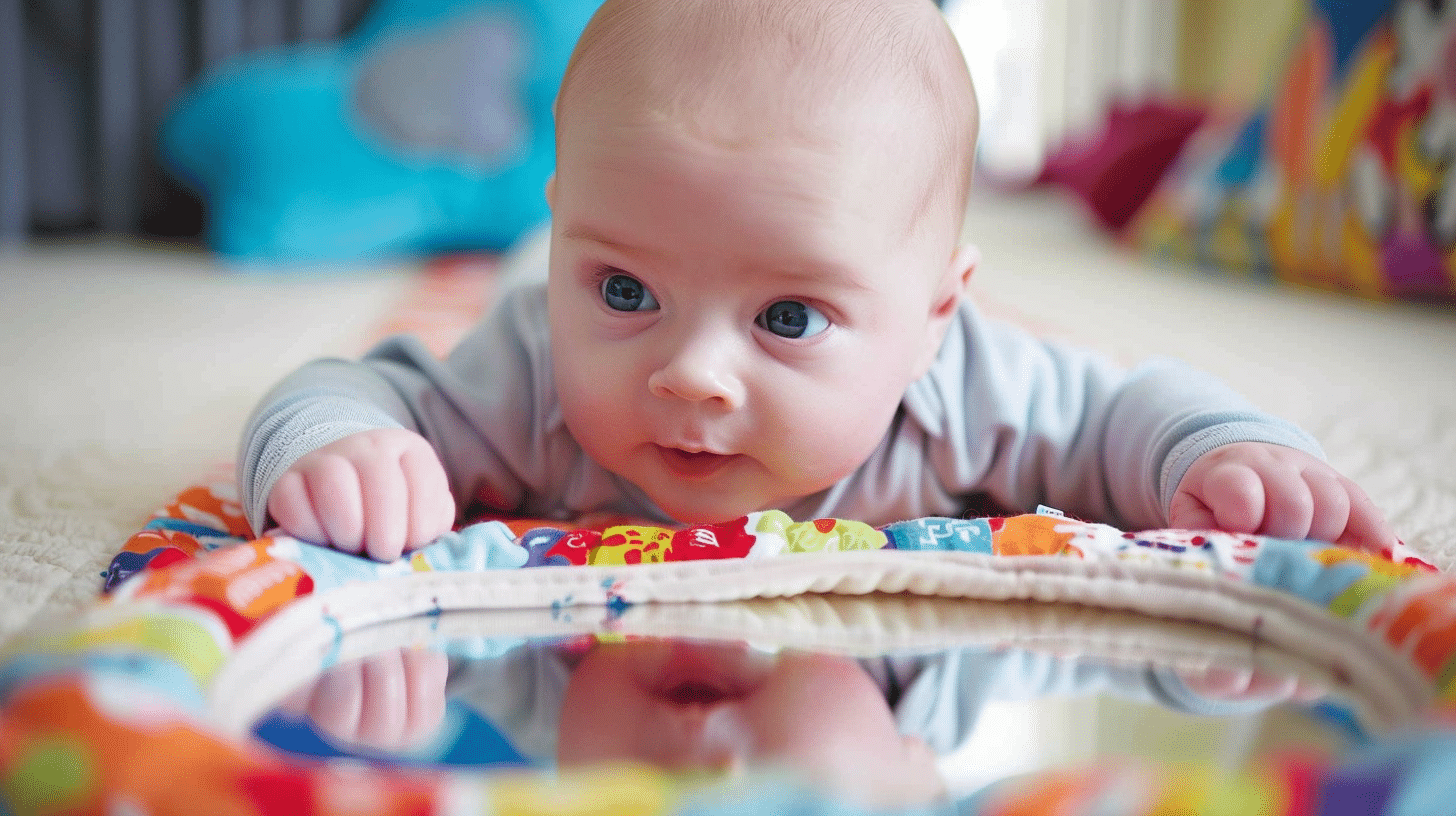
Place a baby-safe mirror on the floor during play sessions. Babies are naturally fascinated by their reflection and may smile, reach, or babble when they see movement in the mirror.
This activity encourages visual focus and lays the groundwork for early self-awareness.
Keeping the mirror at the baby’s eye level also supports neck and upper body strength as they lift their head to look.
6. Tracking Objects
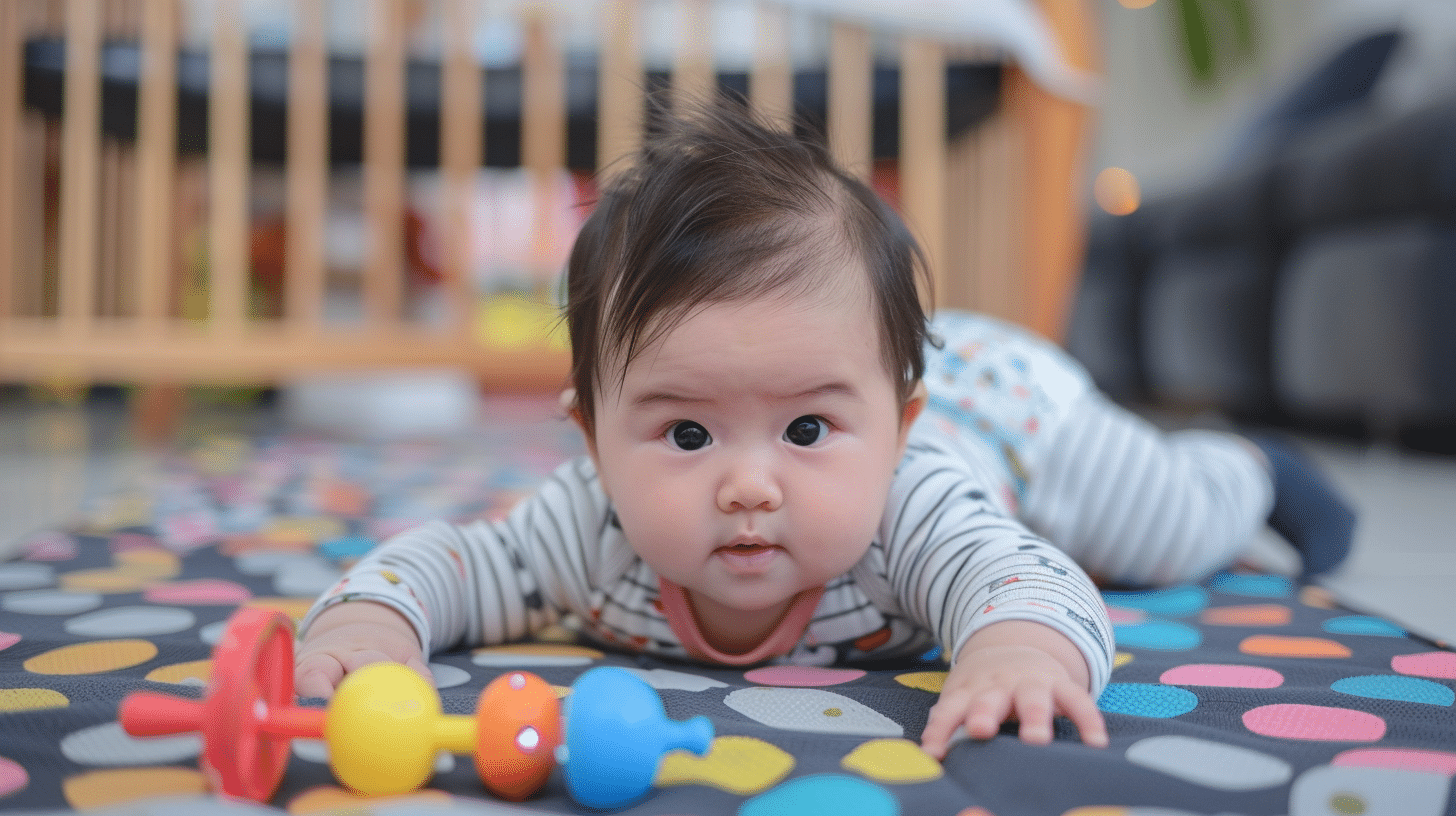
Use toys that move or make sounds, such as mobiles, rattles, or light-up toys, to help your baby practice following with their eyes.
Slowly move the toy from side to side or up and down while your baby lies on their back or tummy.
This strengthens vision, builds attention span, and improves hand-eye coordination as they eventually reach for the object. Tracking games also prepare babies for more advanced motor skills later on.
7. Peekaboo and Object Permanence

Playing peekaboo or hiding a toy under a cloth teaches your baby that objects continue to exist even when out of sight.
This builds early problem-solving skills and encourages curiosity. It also keeps your baby happily engaged and connected with you during play.
Repeating these simple games daily supports both cognitive and social growth.
8. Exploration Time
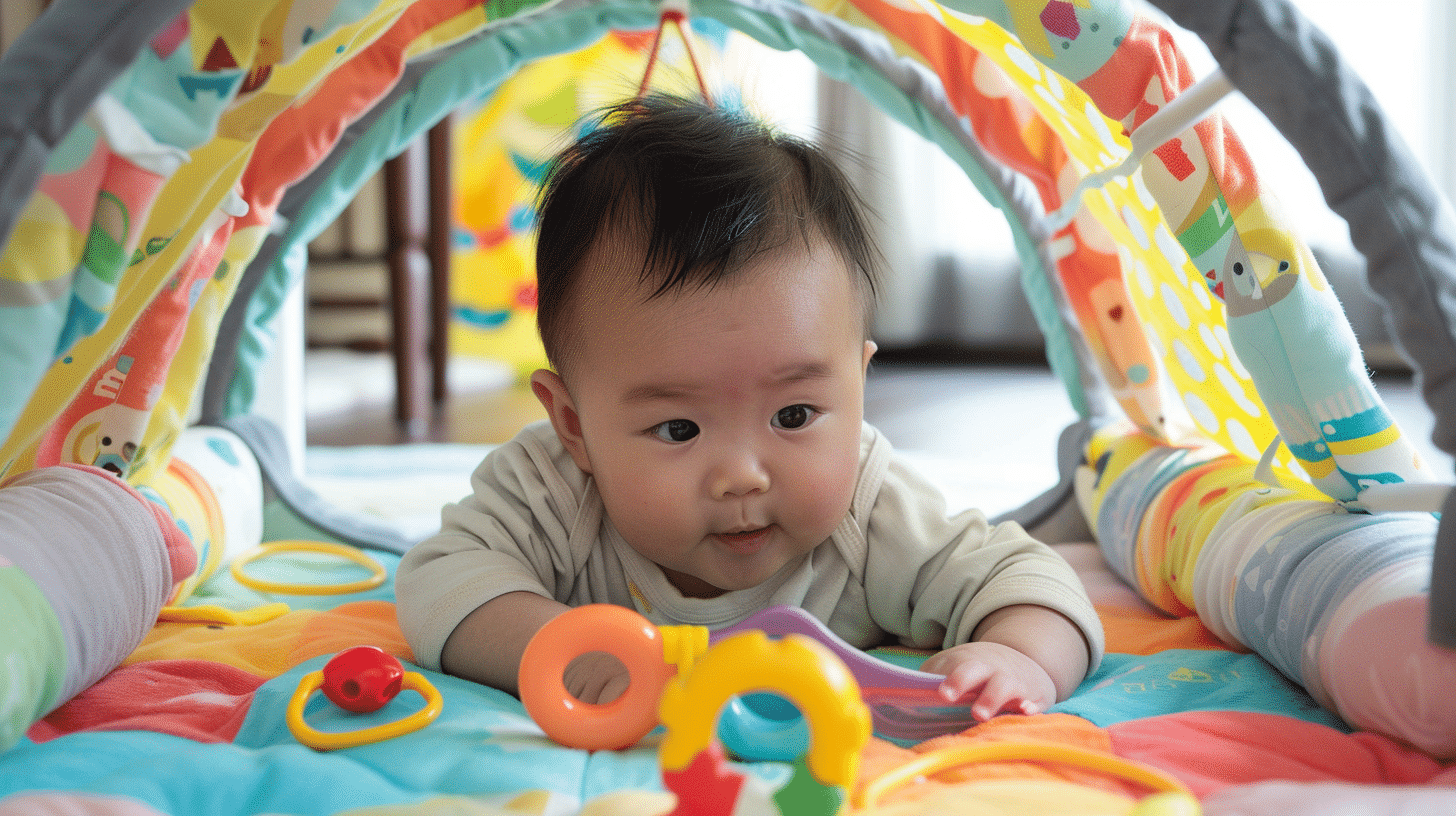
Setting your baby on a safe play mat or under a play gym with simple objects like rattles, rings, or soft blocks encourages reaching and grabbing.
These actions help babies understand cause and effect while building coordination. Exploration time also stimulates curiosity by giving your baby new shapes, colors, and textures to interact with. Keep items safe, light, and easy to handle.
9. Face-to-Face Interaction

Looking into your baby’s eyes, smiling, and responding to their sounds helps strengthen your bond while also supporting emotional growth.
These exchanges teach your baby the basics of communication, showing them that their coos and expressions matter.
Daily face-to-face interaction fosters trust and encourages early social skills that will continue to develop over time.
10. Talking and Singing

Narrating daily routines or singing during activities like feeding or diaper changes helps your baby connect words with actions.
Hearing the rhythm of speech and song introduces them to language patterns.
These interactions also make everyday care moments meaningful while laying the foundation for communication skills. Keep your tone varied and expressive to hold their attention.
11. Reading Picture Books

Pointing to and naming objects in simple picture books builds recognition and introduces new sounds.
Reading together not only develops early literacy but also strengthens attention span. Short sessions with colorful, age-appropriate books keep babies interested without overwhelming them.
Over time, they begin to connect spoken words with the images they see.
12. Grasping Toys
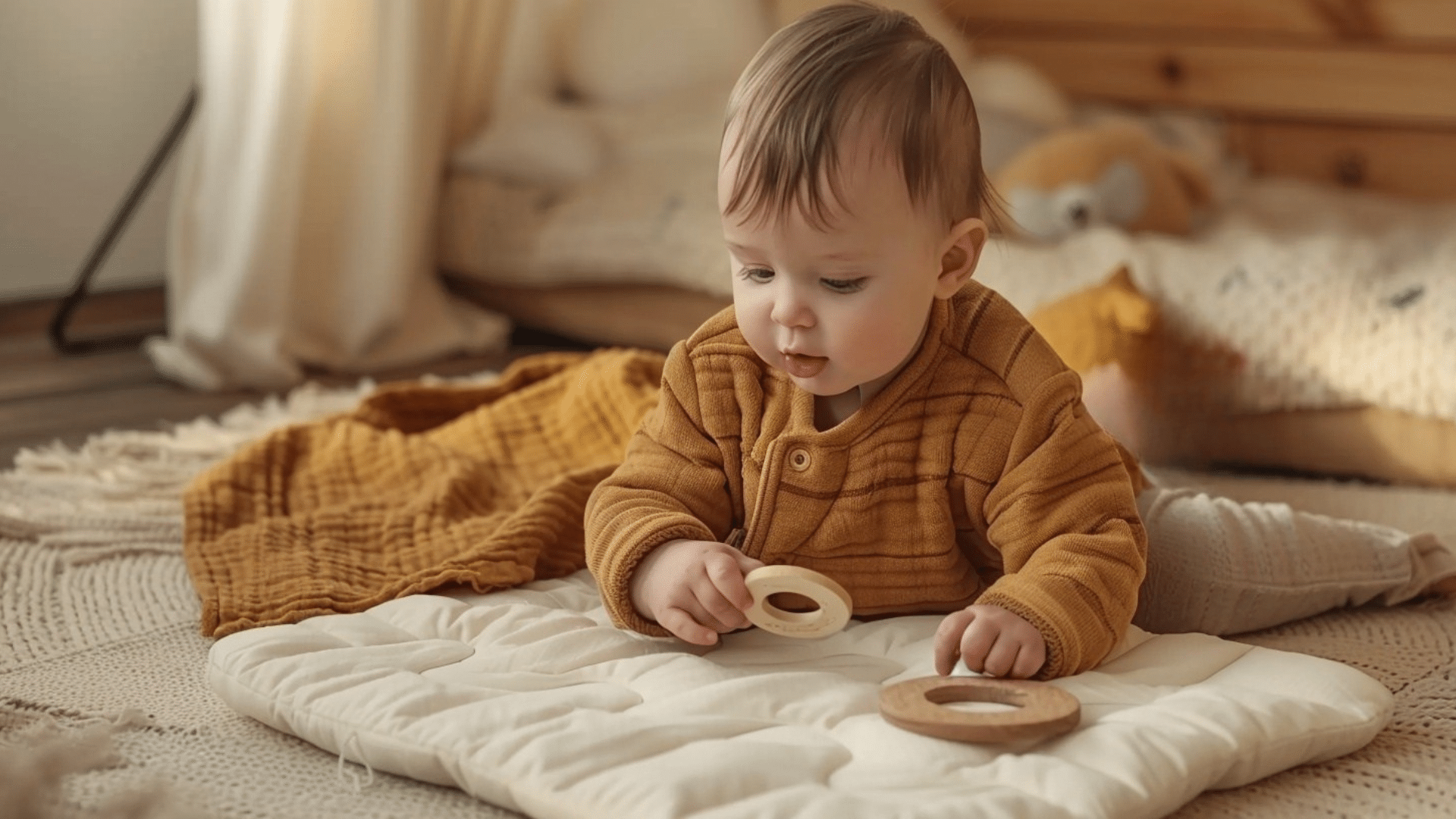
Simple wooden rings, rattles, or cloth toys allow babies to practice holding and releasing.
These movements strengthen hand muscles and build coordination. Avoid overly stimulating toys so your baby can focus on learning control. Rotate toys often to keep the experience engaging and fresh.
13. Montessori vs. Conventional Play
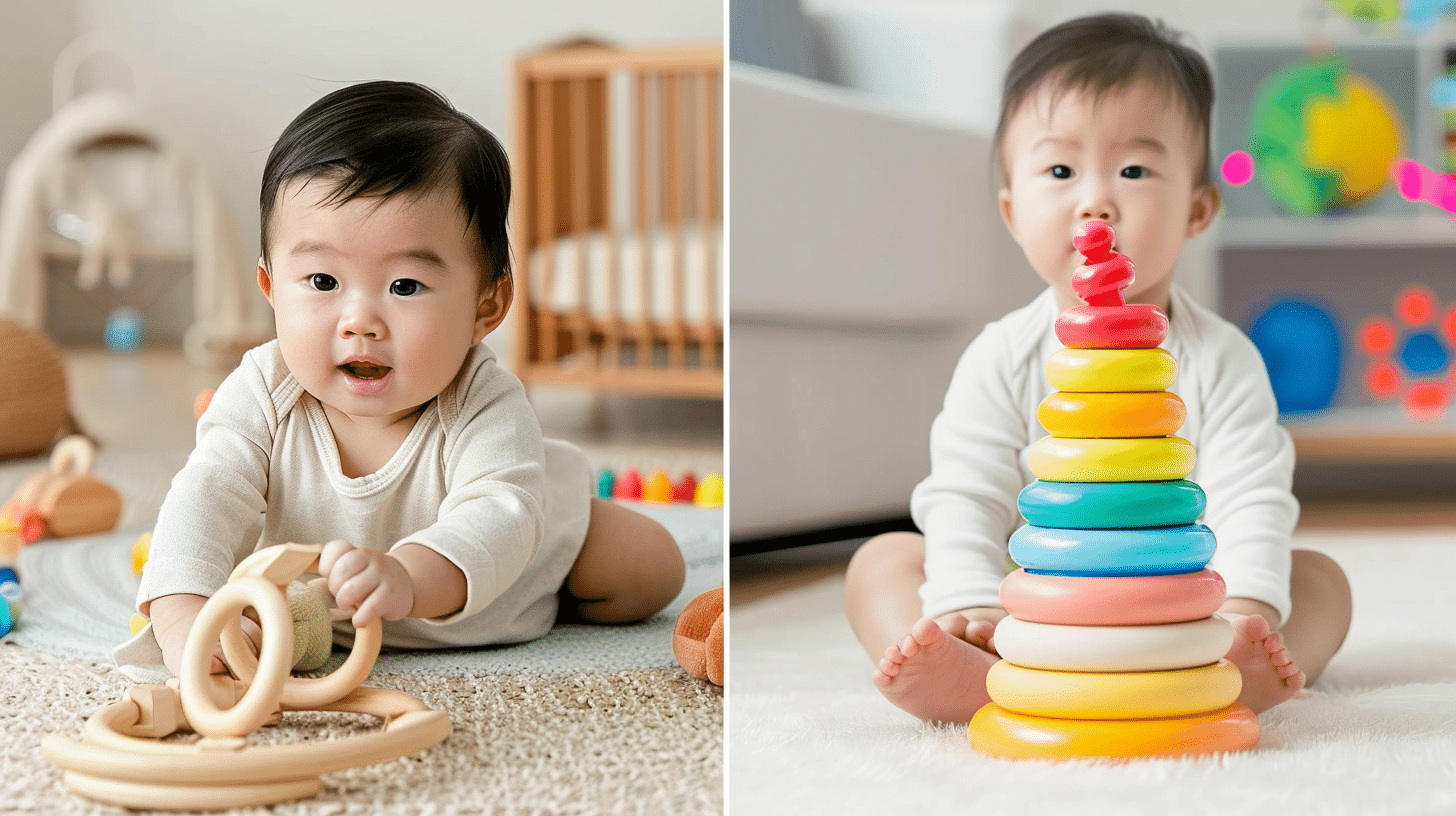
Montessori-inspired play emphasizes simplicity, natural textures, and independence, while conventional toys often rely on bright lights and sounds.
With Montessori activities, babies learn at their own pace without overstimulation. This approach promotes focus, curiosity, and meaningful interaction with real-world objects.
Parents can blend both methods depending on their baby’s needs.
14. Treasure Baskets
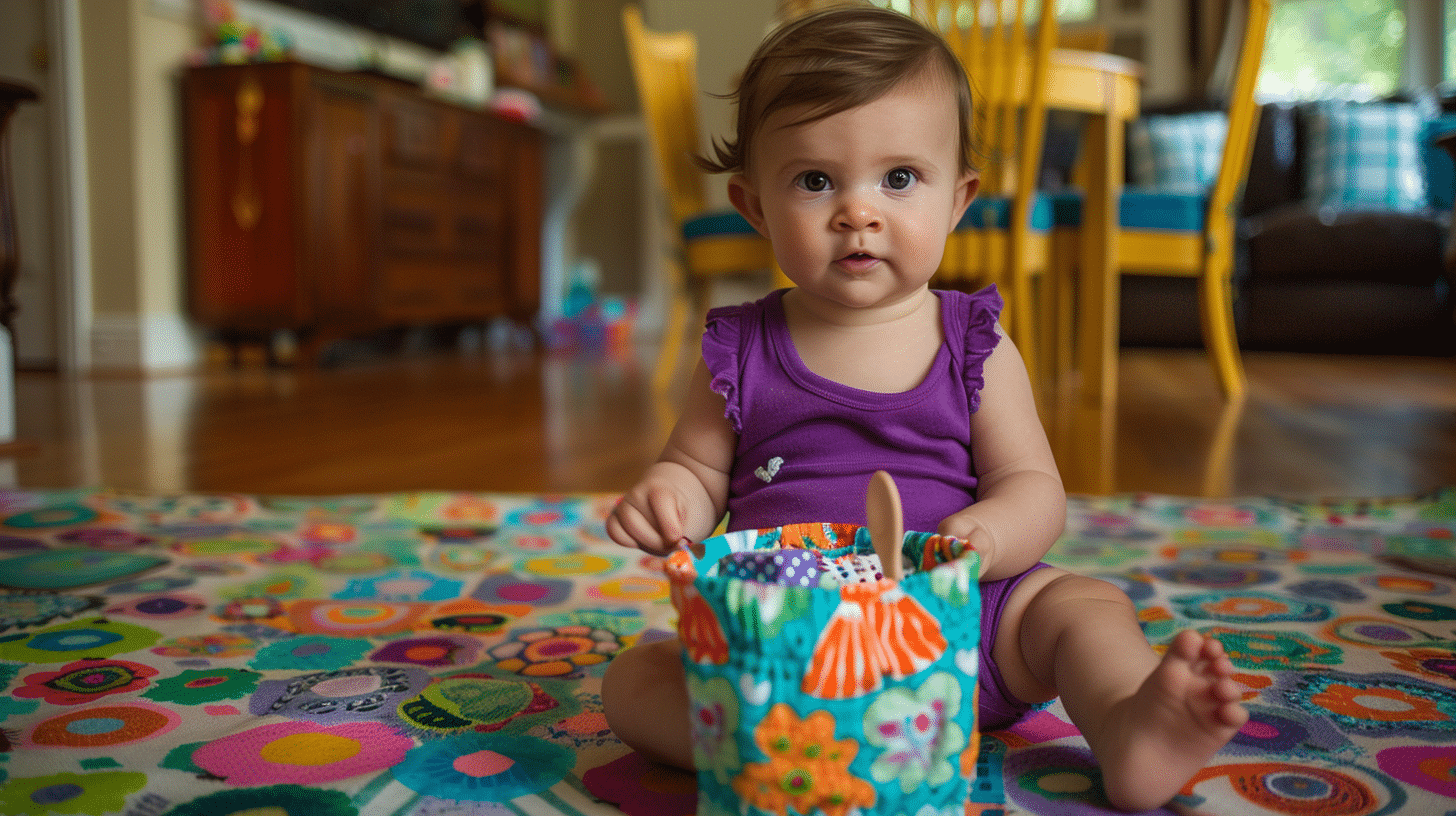
Fill a small basket with safe household items such as wooden spoons, fabric scraps, or baby brushes. Babies enjoy finding different textures, weights, and shapes while developing fine motor skills.
This simple activity also encourages curiosity and learning.
Baby Safety and Comfort Tips
Keeping your baby safe during play, rest, and daily routines is just as important as supporting their development.
- Play mat safety: Always use a clean, flat, padded mat. Keep the area free of small objects, cords, or sharp items.
- Toy size for choking prevention: Choose toys larger than your baby’s mouth. Avoid items with detachable small parts; bigger than a closed fist is a safe rule.
- Tummy time duration: Begin with a few minutes at a time and work up to 20–30 minutes spread throughout the day. Always supervise closely.
- Safe sleep reminders: Place your baby on their back on a firm mattress without pillows, blankets, or stuffed animals.
- Signs of overstimulation: Look for head turning, eye rubbing, fussiness, sudden crying, stiffening, or unusual quietness. Calm them in a quiet, dim space, hold gently, or use soft singing.
- Breaks between play: Short pauses between sessions help your baby reset and avoid overwhelm.
Tools & Resources for Parents
Parents can benefit from having reliable tools that make baby care easier and more reassuring.
A free milestone tracker or printable checklist helps you keep track of your baby’s growth and development in one place.
Trusted sources such as the CDC and UNICEF provide clear guidelines on what to expect at this stage and when to seek advice.
Along with this, a list of recommended toys and books that are safe and age-appropriate can give you practical options to support learning and play without feeling overwhelmed.
Conclusion
Parenting a 4-month-old is a journey filled with small understanding and joyful progress.
Every baby develops at their own pace, so focusing on connection, patience, and gentle encouragement will help you enjoy this stage as much as your little one.
Trust your instincts, celebrate milestones as they come, and don’t feel pressured to follow every guideline perfectly. The most important thing is being present and creating a safe, loving space for growth.
Ready to support your baby’s development? Start adding one new activity today and watch how even small moments build lasting bonds.











